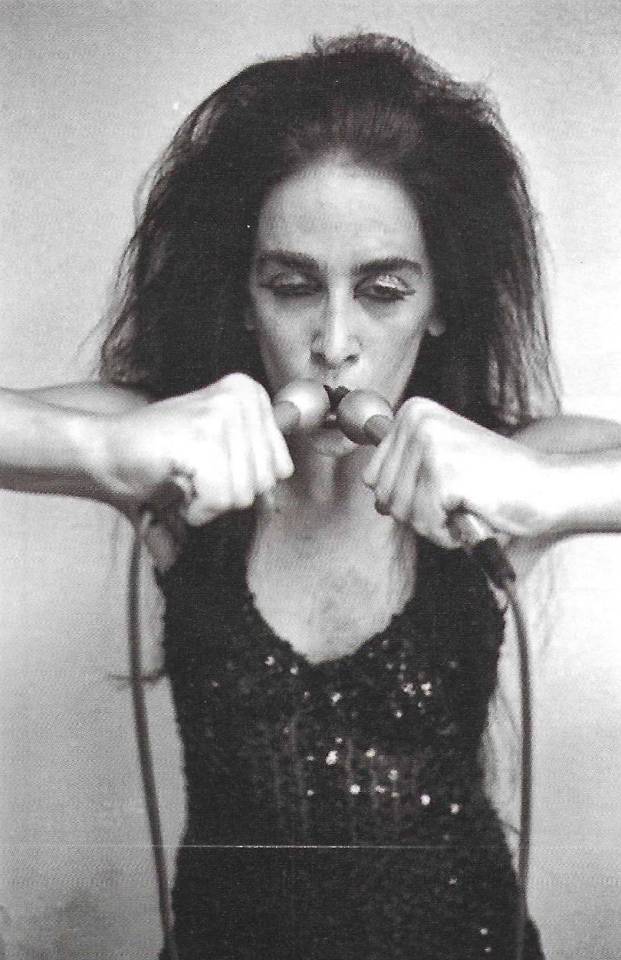#peggy phelan
Text

'telephone pole' by kim jones in live art in LA: performance in southern california, 1970-1983 - peggy phelan (2012)
2K notes
·
View notes
Text
scholars on performance studies
Andre Lepecki is a scholar, writer, and performer who is well-known for his contributions to the field of performance studies. He is an Associate Professor of Performance Studies at New York University's Tisch School of the Arts, where he teaches courses on contemporary performance and dance.
Lepecki is best known for his writings on the history and theory of contemporary performance art, dance, and choreography. His work explores the relationships between performance, politics, and the body, and he is particularly interested in the ways in which performance can be used as a tool for critique, resistance, and transformation. He has written extensively on the works of leading contemporary choreographers and performance artists, and his writing is known for its clear and engaging style, as well as its interdisciplinary approach to the study of performance.
Some of Lepecki's most notable works include his books "Exhausting Dance: Performance and the Politics of Movement" (2006), "Singularities: Dance in the Age of Performance" (2016), and "The Oxford Handbook of Dance and Politics" (2018), co-edited with J. Smoak. These works have been widely read and highly regarded by scholars and practitioners in the field of performance studies, and they have helped to shape ongoing debates about the role of performance in contemporary culture.
In addition to his writing, Lepecki is also an active performer and has collaborated with a number of leading contemporary dance and performance artists. His work as a performer and his writing on performance are closely interrelated, and his commitment to the performative aspect of his scholarship is one of the hallmarks of his approach to the study of performance.
Peggy Phelan - Phelan is a Professor of Performance Studies at New York University, and she is known for her writing on the performative aspects of identity and the ways in which performance can challenge dominant cultural narratives.
Diana Taylor - Taylor is a Professor of Performance Studies and Spanish at New York University, and she is known for her work on the political dimensions of performance, particularly in the context of Latin American culture.
Matthew Reason - Reason is a Professor of Performance Studies at Royal Holloway, University of London, and he is known for his work on the relationship between performance and activism, and the ways in which performance can be used as a tool for social change.
Shannon Jackson - Jackson is a Professor of Rhetoric and Theater, Dance, and Performance Studies at the University of California, Berkeley, and she is known for her work on the intersection of performance and politics, and the role of performance in public life.
Jill Dolan - Dolan is a Professor of English and Theater Studies at Princeton University, and she is known for her work on the politics of representation in contemporary performance, and the ways in which performance can challenge dominant cultural narratives and construct new forms of identity.
Richard Schechner - Schechner is a Professor of Performance Studies at The New School in New York, and he is known for his work on the interdisciplinary nature of performance, and the ways in which performance can be used as a tool for cultural critique and transformation.
Tim Miller - Miller is a performer and a Professor of Performance Studies at University of California, Los Angeles, and he is known for his work on the political dimensions of performance, particularly in the context of LGBTQ activism.
E. Patrick Johnson - Johnson is a performer, scholar, and the Carlos Montezuma Professor of Performance Studies and African American Studies at Northwestern University, and he is known for his work on the intersections of race, sexuality, and performance, and the ways in which performance can challenge dominant cultural narratives and construct new forms of identity.
Tom Breedveld - Breedveld is a performance scholar and Associate Professor at Utrecht University in the Netherlands, and he is known for his work on the intersections of performance, technology, and activism, and the ways in which performance can be used as a tool for social change.
Lynne Gardiner - Gardiner is a performance scholar and Associate Professor of Theatre and Performance at the University of British Columbia, and she is known for her work on the intersections of performance, politics, and activism, and the ways in which performance can challenge dominant cultural narratives and promote social justice.
These are just a few examples of the many scholars who have contributed to our understanding of the transformative power of performance. Their work is essential to the ongoing development of the field of performance studies and has helped to shape our understanding of the role of performance in contemporary culture.
Joshua Landy - Landy is a Professor of French and Comparative Literature at Stanford University, and he is known for his work on the relationship between performance and subjectivity, and the ways in which performance can challenge dominant cultural narratives and construct new forms of subjectivity.
José Munoz - Munoz was a performance scholar and Professor of Performance Studies at New York University, and he is known for his work on the relationship between performance and desire, and the ways in which performance can challenge dominant cultural narratives and construct new forms of desire.
Brian Massumi - Massumi is a philosopher and Associate Professor of Communication Studies at the University of Montreal, and he is known for his work on the relationship between performance and affect, and the ways in which performance can challenge dominant cultural narratives and construct new forms of affect.
Martin Roth - Roth is a performance scholar and Professor of Performance Studies at The New School in New York, and he is known for his work on the relationship between performance and the unconscious, and the ways in which performance can challenge dominant cultural narratives and construct new forms of subjectivity.
These are just a few examples of the many scholars who have explored the relationship between performance art and consciousness. Their work has helped to deepen our understanding of the ways in which performance can challenge dominant cultural narratives and construct new forms of subjectivity, desire, affect, and the unconscious.
5 notes
·
View notes
Text
parallel reading peggy phelan…you don’t know the real insanity…
0 notes
Text
Journal #5: Men on Boats Stage Moodboard

Thinking about some of the stage and set designs for men on boats, I would want to consider the canyon structures and the rapids, which ground the setting of the play. Some of the most intense scenes of the play happen when the characters are in the middle of trying to run the rapids. I would love to focus on this element of water and movement. I’m already thinking about using projections of water in conversation with the canyon walls that I would like to include in my staging––which also alludes to the sounds of water crashing against rocks. In my opinion, the color of the canyon walls adds to the lighting that I envision for my staging of the play. I'm particularly thinking about the warm hues of orange, browns, and red for the play's lighting.
During our conversation with Gavin, Gavin made many good points that I wanted to consider in the images I pulled for my mood board. One of the points that Gavin considered in his staging for Men on Boats is playing with depth. In some of the productions I've seen from Men on Boats, the staging seems often flat, as if the characters are the same height as the walls of the canyon.
One thing I remember Gavin saying about this point is that in his design, he wanted to emphasize the idea that these canyon wall structures were larger than life compared to the size of these figures going on the exploration. In doing so, I chose images in my mood board that reflected this idea and played with depth, dimension, and height. For instance, the bottom left image is of a figure staring up at the canyon walls. The canyon walls surround this figure all around them. The image alludes to the fact that humans are just a small glimpse into these really large structures.

The mood board above looks at the lighting design I envision for my staging for Men on Boats. In my staging, I envision staying true to the warm colors associated with the canyon landscape. In staying truthful to nature, I envision that at the higher points of the canyon wall, there will be more warmth, as I want to play with this idea that the top of the canyon walls are being sunkissed by the sun above. However, as we go deeper into the canyon walls and deeper into the walls, the sun is not able to reach our touch at these very low points. Thus, I envision that the bottom of my stage will be cooler than the top points of the canyon. Visually, I think that this will create an appealing contrast to the staging, adding variation to the landscape.

Lastly, the other area of staging that I want to focus on for my staging of Men on Boats is the costuming. It should not go unnoticed that while the play is about men, men are not playing men. It is female-identifying bodies who are emulating and playing historical male figures. There is something to be said about Men on Boats breaking the masculine mold often associated with historical American expeditions, that have for the most part, if not all, been exclusive to white men only. This is revolutionary.
In my staging for Men on Boats, I want my costumes to be able to reflect this reshaping and reconfiguring of the often associated masculine mold. The images above reflect clothing of the 1860s, during the time of the expedition. The picture to the left is a photograph of John Wesley Powell. The image in the middle and the image at the bottom are both of John Wesley Powell's state-sanctioned expedition. There is a lot of structure in the garments Powell is wearing. The frock coats, for instance, exude a broad and exaggerated shape. I would want to keep these broad and exaggerated proportions on the costumes I envision. The shape of these costumes would be a great contrast to what we might typically associate with feminine clothing on feminine-identifying bodies.
In The Ontology of Performance, Representation without Reproduction, Peggy Phelan highlights that "in employing the body metonymically, performance is capable of resisting the reproduction of metaphor, and the metaphor I’m most keenly interested in resisting is the metaphor of gender, a metaphor which upholds the vertical hierarchy of value through systematic marking of the positive and the negative."
Put differently, performance can enable its artists to emulate and represent different gender identities. For Phelan, there is power in this disappearance of the body––where the body comes to represent another idea or concept because this disappearance complicates our conventional understanding of a binary way of thinking about gender.
I'm hoping that the costumes I envision for my staging of Men on Boats reflect this resistance to gender norms––complicating the idea of what it means for female-identifying performers to wear traditionally masculine clothing and how that specifically is able to subvert our preconceived notions about who is able to tell this story based on gender.
Men on Boats follows the story of real-life men expanding the white man's world––often at the price of indigenous and communities of color. The playwright, Jacklyn Backhaus, flips this idea by cementing a place for non-white cis men to tell that story. It is opening the lens for people of color and the underrepresented to take part in that historical account and conversation that has not included them. Men on Boats is an assertion that performance and storytelling as a device, have the potential to offer a new alternative to storytelling––one that subverts dominant narratives that see gender as a binary and at the same time opens the door for more than just cis-white men to tell stories about cis-white men. We are pushed to consider what stories are being told and what stories aren't. Performance pushes us forward to reimagine a more inclusive role in storytelling.
Another thing that Gavin mentioned in our conversation was this idea of replicating nature through theatricality. Gavin mentioned that replicating nature is very hard because nature cannot be mirrored identically. Therefore, in his staging, Gavin is really tapping into the theatricality of scenery and exaggerating the canyon wall structures. Keeping this in mind, one of the images that I decided to include in my moldboard is an oil painting of water crashing on rocks. In the image, you can really get a sense of the brush strokes, and while you can tell that the art is of a landscape, there is a whimsical element to the painting. I'm also hoping to consider this idea with my staging of men on boats.
0 notes
Text
You can still find a used copy of the catalog on AbeBooks.
WACK!
Art and the Feminist Revolution
Edited by Cornelia Butler and Lisa Gabrielle Mark
512 pp., 9 x 11 in, 475 color illus.
The 2007 exhibition catalogue—also titled WACK!: Art and the Feminist Revolution—documents this first major retrospective of art and the feminist revolution. Edited by Cornelia Butler and Lisa Gabrielle Mark, it has essays by Butler, Judith Russi Kirshner, Catherine Lord, Marsha Meskimmon, Richard Meyer, Helen Molesworth, Peggy Phelan, Nelly Richard, Valerie Smith, Abigail Solomon-Godeau, and Jenni Sorkin. - Wiki
1 note
·
View note
Quote
Our writing was and is sometimes a river of consolation and sometimes a river of grief without end. (A lamentation, a keening, a song.) A writing that was, a writing that is, in relation to each other, but also more fundamentally in relation to acts of reading and writing that obviated the distinction between each act and between each of us.
Peggy Phelan, from “Hypothetical Focalization and Queer Grief” in Narrative Theory Unbound: Queer and Feminist Interventions
66 notes
·
View notes
Photo

Peggy Phelan - To Suffer a Sea Change
58 notes
·
View notes
Quote
Feminism is the conviction that gender has been, and continues to be, a fundamental category for the organization of culture. Moreover, the pattern of that organization usually favours men over women.
Peggy Phelan
2 notes
·
View notes
Photo

#performance art#peggy phelan#the ontology of performance#I'm writing an essay about a piece of art I made and I !! love !! theory !!
4 notes
·
View notes
Quote
Western theatre is itself predicated on the belief that there is an audience, an other willing to be cast in the role of auditor. The 'act' at the heart of theatre making is the leap of faith that someone (that ideal spectator some call 'God') will indeed see, hear, and love those brave enough to admit that this is the movement that keeps us from our deaths (or at least from permanently dark houses). The psychic problem raised by theatre is that it remains a perpetual rehearsal. The one for whom the theatre maker makes the piece never arrives for the performance ('Nobody/bears witness for the/witness'). This is why theatre remains an art rather than a cure.
From Mourning Sex by Peggy Phelan
#art#theatre#performance#depression#anxiety#god#love#this is the movement that keeps us from our deaths#this is the movement that keeps us from permanently dark houses#death#dark house#god never arrives#love the brave#quote#peggy phelan#nobody bears witness for the witness#cure
5 notes
·
View notes
Photo

Figure 25, Untitled Dance (with fish and others). Angelika Festa, 1987.
#angelika festa#festa#dance#fish projections#feminism#feministart#femartist#peggy phelan#ontology of performance#performance#performance art#partformanceart#feminist art#suspended#cocoon
4 notes
·
View notes
Text


diamanda galas in live art in LA: performance in southern california, 1970-1983 - peggy phelan (2012)
412 notes
·
View notes
Quote
Because I cannot now love you body to body I will try to love you in words.
Peggy Phelan, in Mourning Sex: Performing Public Memories.
#peggy phelan#mourning sex#mourning sex performing public memories#lit#quotes#words#love#body#voice#obstacle
76 notes
·
View notes
Photo



Caravaggio, The Incredulity of Saint Thomas
Peggy Phelan, Mourning Sex: Performing Public Memories
Roland Barthes, A Lover’s Discourse: Fragments
10 notes
·
View notes
Text
Digital Journal #1: Performance
Over the past two weeks, our class participated in the Otzö Kazo workshops. When the idea of the movement workshops was first introduced, I was filled with many apprehensions––dance has never been my “thing” and I’m not sure why but dance has had a tendency to make me self-conscious regarding other’s perceptions of my movement. Going into these workshops, I recognized that I wasn’t the most excited about them but either way, I decided to keep an open mind with this workshop. This self-consciousness was only heightened during the first workshop with Ari when I joined virtually over Zoom.
When I tuned into the workshop, I tuned in from what I thought was a hidden and secluded hallway at the Clarice. I thought it was the perfect spot to move around and tap into movement but the exact opposite ended up happening. As I tuned into the workshop from the hallway, there were students and other faculty members passing through and I found myself having to stop going “full out” and became distracted anytime I heard the door open. Because of this, I could not devote myself completely to the workshop. My attention was undoubtedly distracted and I certainly did not make the most out of that workshop.
This is why when I found out that we would be continuing the workshop in person this past Tuesday, I was really looking forward to that experience and almost saw it as my personal redemption and goal to at least try and make the most out of it. Last workshop, the space that I was in presented a huge hindrance to being able to fully immerse and participate in the workshop. Going into the workshop on Tuesday, I knew that a change of scenery would make this experience more enjoyable––and this proved to be true. While I felt nervous about going into the workshop, I was comforted in knowing that there would be others participating in the same event and also dancing––so no judgment here!
Looking back at the workshop on Tuesday and comparing it to the workshop that we had last week, I really enjoyed Tuesday’s workshop because I found the music to be particularly helpful in connecting with my emotions and channeling the music (and the rhythm emanating) through my physicality. I also found the music to be grounding. It grounded me in my moment and I felt a more natural energy radiate throughout my body, which allowed my movements to be a lot more organic––my body had something to respond to. Compared to the first workshop that I tuned into, I had a really hard time letting go and had difficulty translating Ari’s description of the characters into my movement. While Ari was descriptive of the emotions and characteristics of each character, it was hard for me to find a connection with what she was describing. However, I found the music to really help with tuning out any extra noise, and for me, I saw the music as an invitation for my body to really listen to the rhythm and follow the emotions that were associated with the specific sounds.
The character that I felt a connection with was Azueli. I think I could connect with Azueli because Azueli’s form is in the form of the ocean. Azueli’s character gave me a visualization that I could connect to. I thought a lot about the ocean and the movement of the waves. As Peggy Phelan states in The Ontology of Performance: The Politics of Performance, “In performance, the body is metonymic of self, of character, of voice, of ‘presence.” Thus, in some capacity, as the performer (in the case of the workshop), I “disappeared” and “represented” “something else––dance, movement, sound, character, art” (Phelan, 150). Because Azueli is not aware of her existence, I remember trying to translate this through my physicality. I remember starting off by gently swaying side to side with a sort of gentle ease. Once Azueli has a realization that she exists, I remember expanding my movement and using my arms to make wave ripples with my hands.
I’m not sure why but when thinking about Azueli, I had flashbacks to Moana (maybe because water is such a focal point of the movie, but also because of how therapeutic and tranquil I find the scenery to be in that movie). During the workshop, there were moments that definitely surprised me. For most of the story, I kept moving my eyes closed (for me personally, closing my eyes allows me to really connect with myself and really focus on my hearing sense). However, towards the end of the story, I found myself going down on the floor. Truth be told, I felt a little tired and could use the rest but something about the shift in low deep grave tone coming from the music made me associate a lower level with my body. When I started to go down, I remember opening my eyes and seeing about half the room dancing on the floor. It was so surprising to see the room's similar and collective response to energy.
0 notes
Photo





Helena Almeida: My work is my body, my body is my work, [exhibition] Curated by João Ribas and Marta Moreira de Almeida, Essays by Peggy Phelan, Connie Butler, and Bernardo Pinto de Almeida, Serralves Museum, Porto, 2016. Design: R2
#graphic design#art#exhibition#catalogue#catalog#cover#helena almeida#r2 design#lizá ramalho#wogd#artur rebelo#joão ribas#marta moreira de almeida#peggy phelan#connie butler#bernardo pinto de almeida#serralves museum#2010s
67 notes
·
View notes